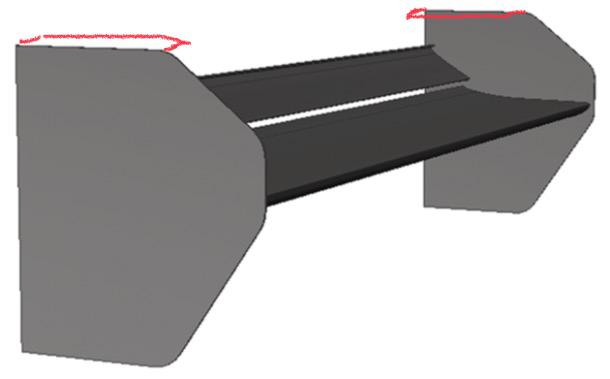Not an engineer by any stretch, but have been reading about wing and end plate design. I have a question that I can't seem to find an answer to.
The high pressure air is trying to wrap around the end of the wing element to the low pressure zone below the element, thus the end plate. However, the high pressure air still attempts to wrap over the top of the end plate. This is why some designs have slots in the end plates so the vortices get pulled back through the end plate to the top side of the wing.
So why not have a design like the crude addition to the render below to stop the high pressure vortices from traveling up and over the endplate?
context: autocross car with top speeds in the 70s, so looking for maximum downforce as opposed to worrying about drag.

The inboard facing wickers you have sketched will REDUCE total downforce. The mechanism is: the high pressure air on the top surface of the wing will effectively be mirrored to the bottom face of the wicker, generating nearly zero total downforce for the overlapped area. The area is small but not zero.
The effect is generally refered to as the "Biplane effect". Two objects near each other react to the pressure between them. The same thing happens when a wing is mounted over/near the deck/trunk of a car. The distance of separation will control how much impact it makes.
In reply to stafford1500 :
This reminds me of a question I had. I saw a race car (c6) recently that has a wing over the rear body but also has a somewhat large (zr1) spoiler under it on the back of the bumper cover.
I asked and he said that the viper ace is set up like that.
Will it reduce the wing's efficiency or help?
In reply to jfryjfry :
Just saw your post...
Yes the spoiler under the wing will reduced the wings effectiveness. However, it may change the flow out at the ends enough to recover the center efficiency loss. We had a similar configuration on the Saleen S7 in FIA GT and ACO/European LeMans Series. It was not the biggest difference in the world to switch them shorter tracks, but it was definitely better to remove the spoiler for LeMans.

stafford1500 said:
The inboard facing wickers you have sketched will REDUCE total downforce. The mechanism is: the high pressure air on the top surface of the wing will effectively be mirrored to the bottom face of the wicker, generating nearly zero total downforce for the overlapped area. The area is small but not zero.
The effect is generally refered to as the "Biplane effect". Two objects near each other react to the pressure between them. The same thing happens when a wing is mounted over/near the deck/trunk of a car. The distance of separation will control how much impact it makes.
We did some experimentation with that at the Open Track Challenge in 2003 or so. We had a high mount and a low mount for the wing - the low one was something like 60% of the chord, hoping to take advantage of some sort of ground effect between the trunk lid and the wing. It was suggested by Dan Bond, the designer of the Nemesis race plane. I never got to drive it, the driver reported it worked well but we didn't get a chance to properly instrument it because of a lack of testing time. I should investigate it again just for interest.

This is one of the reasons I prefer to think of these things as "flaps" and not "wings". It's better to think of the possible benefit of mounting the rear element closer to the body as more akin to a "flap slot" (or 'Fowler Flap Slot') than 'ground effect to the body'. Which leads to beneficial interactions possible because of the way the flow from the flap is interacting with the rest of the flow around the car... complicated by the frequently 3D flow effects from the roofline contracting both vertically and horizontally. The more likely ground effect, though, is actual ground effect... since you're now placing the rear foil much closer to the ground (potentially within 0.5-1 wingspan width).
also, re: 'spoiler under a wing"....
I've got some YouTube links to a tuft test an acquaintance did with an FactoryFive Daytona Coupe that had an "APR 3D element" mounted on it. By changing the height of the rear spoiler on the body they were able to match the in-flow angle across the span of the APR element (I.e. this is, imho, what stafford is referring to when he says "However, it may change the flow out at the ends enough to recover the center efficiency loss"). Generally speaking, the roof shape has a large impact on the AoA of the rear element, especially w.r.t. the portions of the rear element that might extend outside the greenhouse volume... which with a "constant twist foil section" will lead a designer/fabricator into having to compromise the foil performance in the middle of the tips.
A DaytonaCoupe is probably an extreme example of this, though... because it has a rounded rear kamm back shape which is heavily encouraging from the sides of the car to wrap around onto the rear window... especially in comparison to the flat-top and wide fenders of a C5+later corvette. (again, imho)
It's quite possible that our aerodynamicist used something besides the term "ground effect". I was the guy making the brackets, not talking to him directly - and it was 20 years ago :) I may have mapped his desired effect to my understanding of ground effect and so that's the term that is lodged in my head. But whatever the term, it was the interaction between the two surfaces we were after.






























